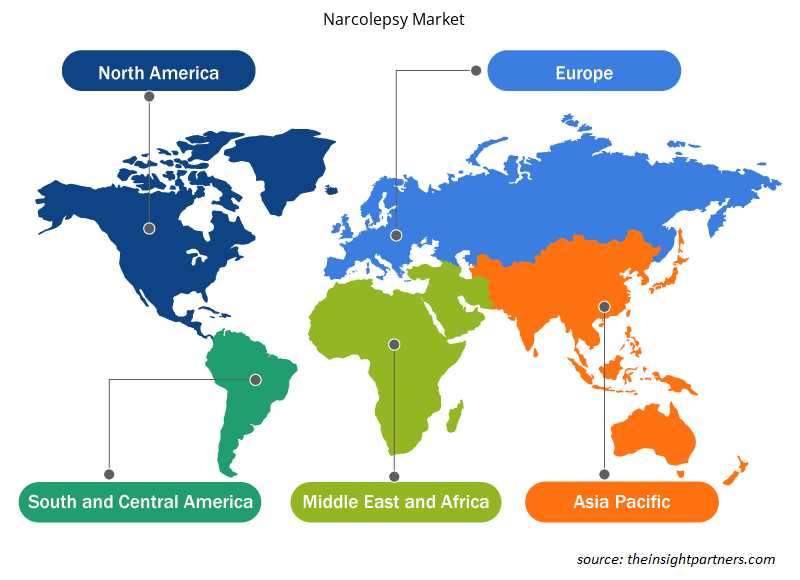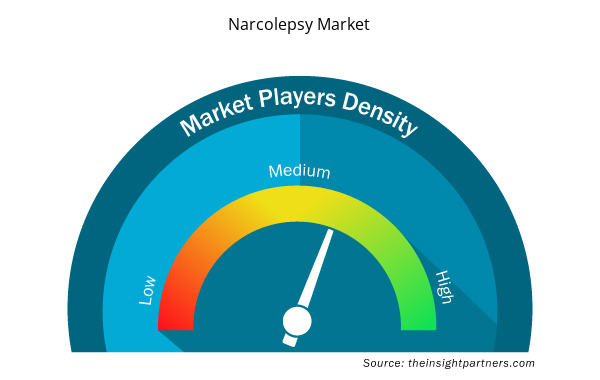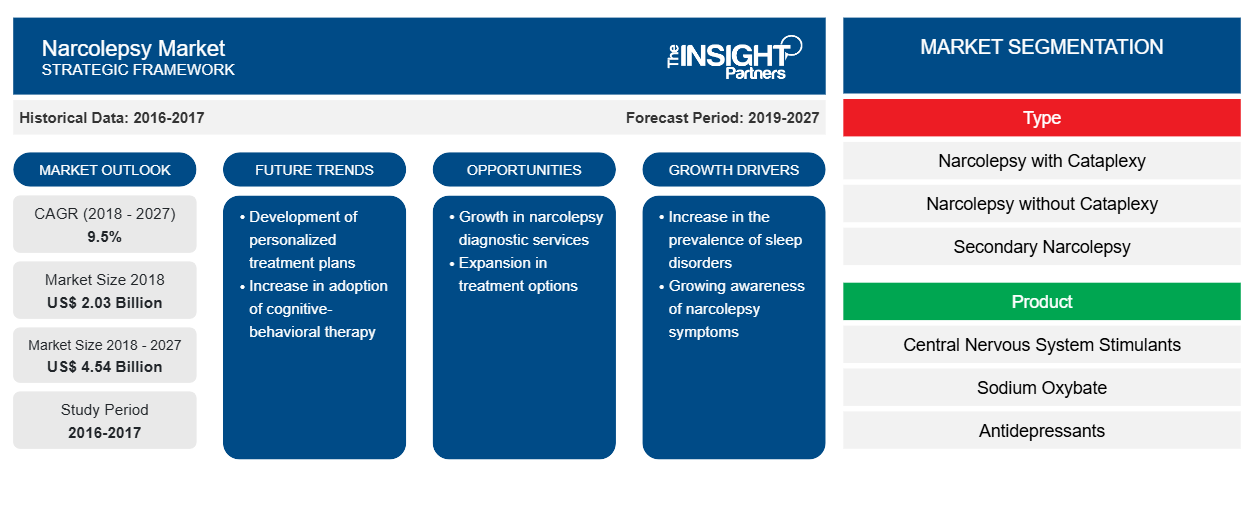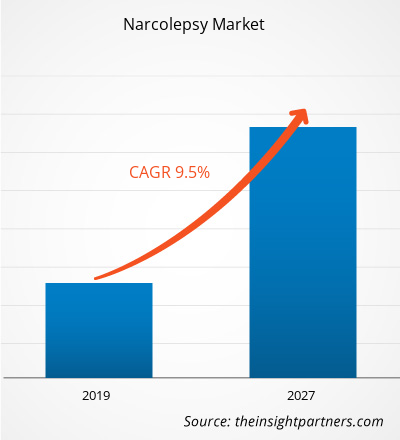嗜睡症市场规模预计将从 2018 年的 20.268 亿美元增至 2027 年的 45.379 亿美元;预计2019-2027 年期间的复合年增长率为 9.5%。
嗜睡症是一种罕见的长期脑部疾病,其特征是某些患者过度嗜睡、睡眠麻痹、幻觉和猝倒发作。嗜睡症在男性和女性中的发病率相同,全球嗜睡症发病率估计约为每 2,000 人中 1 人。嗜睡症患者在白天感到非常困倦,可能会在正常活动中不由自主地入睡。此外,嗜睡症的特征是过度嗜睡和睡眠发作。嗜睡症使人们难以长时间保持清醒,并使他们在一天中的大部分时间都昏昏欲睡。
嗜睡症市场的增长归因于睡眠相关神经系统疾病患病率的上升、新兴的本地制药和生物制药公司以及对神经系统疾病认识的提高。然而,与嗜睡症药物相关的副作用和风险以及疾病的延迟诊断和误诊可能会对嗜睡症市场的增长产生负面影响。
定制此报告以满足您的需求
您可以免费定制任何报告,包括本报告的部分内容、国家级分析、Excel 数据包,以及为初创企业和大学提供优惠和折扣
- 获取此报告的关键市场趋势。这个免费样品将包括数据分析,从市场趋势到估计和预测。
市场洞察
睡眠相关神经系统疾病患病率上升推动嗜睡症市场发展
神经科医生治疗的睡眠障碍范围很广,包括失眠、睡眠呼吸暂停、躁动腿综合症和发作性睡病等。这些疾病会扰乱正常的睡眠-觉醒机制,从而引起内源性异常。随着大量人口将进入老年,预计未来几年神经性睡眠相关疾病将会增加。根据美国国立卫生研究院 (NIH) 的数据,在美国,约有 4000 万美国人患有神经系统疾病,2000 万人偶尔会出现睡眠问题。在过去的几十年里,人们对发作性睡病的病理生理学
有了更多的了解。根据美国国家生物技术信息中心的数据,许多研究已经调查了伴有猝倒的发作性睡病的患病率,每 100,000 人中有 25 至 50 人患有该病。此外,根据 2017 年发作性睡病网络 (Narcolepsy Network) 的数据,美国每 2,000 人中就有 1 人患有这种疾病,即 20 万美国人和全球约 300 万人。此外,美国睡眠呼吸暂停协会 (American Sleep Apnea Association) 报告称,睡眠相关问题影响了 5000 万至 7000 万各个年龄段和社会经济阶层的美国人。然而,在少数族裔和服务不足的人群中,某些睡眠障碍的患病率和严重程度存在重要差异。超过 5000 万美国人已经患有 80 多种不同的睡眠障碍,另外每年还有 2000 万至 3000 万人患有间歇性睡眠问题。患有发作性睡病的人患有慢性日间嗜睡症,并且会在白天意外入睡。这些“睡眠发作”可能发生在任何时间、任何活动期间。睡眠发作不仅限于枯燥或参与度低的活动期间,还可能发生在学校或工作时间、谈话过程中、吃饭时、锻炼或运动时,甚至开车时。因此,睡眠相关神经系统疾病患病率的激增可能会在预测期内推动嗜睡症市场的发展趋势。
基于类型的洞察
根据类型,全球发作性睡病市场分为伴有猝倒症的发作性睡病、不伴有猝倒症的发作性睡病和继发性发作性睡病。2018 年,伴有猝倒症的发作性睡病在发作性睡病市场类型细分中占有最大份额,预计在预测期内也将出现类似趋势。伴有猝倒症的发作性睡病也称为 1 型发作性睡病,是一种罕见的神经系统疾病,诊断依据是脑激素(下丘脑分泌素)水平低或个体报告的猝倒事件。猝倒症是指突然且无法控制的肌肉无力或瘫痪,主要发生在一天内,通常由兴奋或大笑等强烈情绪引发。患者会失去肌肉张力,下巴松弛、说话不顺畅、膝盖弯曲或面部、手臂、腿部和躯干完全无力,而没有太多的预兆。猝倒症患者因无法调节睡眠和清醒状态而导致肌肉张力丧失。在约 10% 的发作性睡病病例中,猝倒症是第一个出现的症状,可能会被误诊为癫痫症。
基于产品的见解
根据产品,全球发作性睡病市场分为中枢神经系统 (CNS) 兴奋剂、羟基丁酸钠和抗抑郁药。2018 年,羟基丁酸钠部分占据了发作性睡病市场的最大份额。羟基丁酸钠也称为 γ-羟基丁酸酯 (GHB),可通过改善发作性睡病患者的夜间睡眠来减少白天嗜睡和猝倒。GHB 用于治疗发作性睡病,这是一种导致严重白天嗜睡的疾病。羟基丁酸钠可以减少白天嗜睡,还可以减少发作性睡病患者可能出现的突然短暂无力/瘫痪肌肉发作(称为猝倒)的次数。这种药物对猝倒症非常有效。羟基丁酸钠有助于改善夜间睡眠,而发作性睡病患者通常睡眠不佳。大剂量使用时,它还可能有助于控制白天嗜睡。必须分两次服用,一次在睡前,另一次在四小时后服用。
基于分销渠道的洞察
根据分销渠道,全球嗜睡症市场分为医院药房和零售药房。2018 年,医院药房部门引领了嗜睡症市场。医院药房是指通常位于医院内的医疗药房。这些药房储存大量药物,主要包括专科药物和研究药物。医院药房通常只为住院患者提供药物,而不是零售机构。医院药房每天可能会根据患者的用药时间表向病房和重症监护室分配大量药物。大型医院可能会使用自动运输系统来帮助有效分配药物。
嗜睡症市场区域洞察
Insight Partners 的分析师已详细解释了预测期内影响嗜睡症市场的区域趋势和因素。本节还讨论了北美、欧洲、亚太地区、中东和非洲以及南美和中美洲的嗜睡症市场细分和地理位置。

- 获取嗜睡症市场的区域特定数据
嗜睡症市场报告范围
| 报告属性 | 细节 |
|---|---|
| 2018 年市场规模 | 20.3亿美元 |
| 2027 年市场规模 | 45.4亿美元 |
| 全球复合年增长率(2018 - 2027) | 9.5% |
| 史料 | 2016-2017 |
| 预测期 | 2019-2027 |
| 涵盖的领域 | 按类型
|
| 覆盖地区和国家 | 北美
|
| 市场领导者和主要公司简介 |
|
市场参与者密度:了解其对商业动态的影响
嗜睡症市场正在快速增长,这得益于终端用户需求的不断增长,而这些需求又源于消费者偏好的不断变化、技术进步以及对产品优势的认识不断提高等因素。随着需求的增加,企业正在扩大其产品范围,进行创新以满足消费者的需求,并利用新兴趋势,从而进一步推动市场增长。
市场参与者密度是指在特定市场或行业内运营的企业或公司的分布情况。它表明在给定市场空间中,相对于其规模或总市场价值,有多少竞争对手(市场参与者)存在。
在嗜睡症市场运营的主要公司有:
- 生物项目
- 梯瓦制药工业有限公司
- 爵士制药公司
- Graymark Healthcare, Inc.
- Arena Pharmaceuticals, Inc.
免责声明:上面列出的公司没有按照任何特定顺序排列。

- 获取嗜睡症市场顶级关键参与者概述
产品发布和批准是公司扩大其全球足迹和产品组合的常用策略。此外,参与者专注于合作战略以扩大客户群,这反过来又使他们能够在全球范围内维护其品牌名称。随着市场参与者开发新的创新产品,市场份额预计将蓬勃发展。一些提供产品的市场参与者包括 Teva Pharmaceutical Industries Ltd;Jazz Pharmaceuticals plc;Arena Pharmaceuticals, Inc;Graymark Healthcare, Inc;Novartis AG;武田制药有限公司;Mylan NV;BIOPROJET;Shionogi & Co., Ltd;和 Ligand Pharmaceuticals, Inc。
- 历史分析(2 年)、基准年、预测(7 年)及复合年增长率
- PEST 和 SWOT 分析
- 市场规模价值/数量 - 全球、区域、国家
- 行业和竞争格局
- Excel 数据集



Report Coverage
Revenue forecast, Company Analysis, Industry landscape, Growth factors, and Trends

Segment Covered
This text is related
to segments covered.

Regional Scope
North America, Europe, Asia Pacific, Middle East & Africa, South & Central America

Country Scope
This text is related
to country scope.
Trends and growth analysis reports related to Life Sciences : READ MORE..
The List of Companies
- Bioprojet
- Teva Pharmaceutical Industries Ltd.
- Jazz Pharmaceuticals, Inc.
- Graymark Healthcare, Inc.
- Arena Pharmaceuticals, Inc.
- Shire (Acquired by Takeda)
- Ligand Pharmaceuticals, Inc.
- Novartis AG
- Mylan N.V.
- Shionogi Inc.
The Insight Partners performs research in 4 major stages: Data Collection & Secondary Research, Primary Research, Data Analysis and Data Triangulation & Final Review.
- Data Collection and Secondary Research:
As a market research and consulting firm operating from a decade, we have published and advised several client across the globe. First step for any study will start with an assessment of currently available data and insights from existing reports. Further, historical and current market information is collected from Investor Presentations, Annual Reports, SEC Filings, etc., and other information related to company’s performance and market positioning are gathered from Paid Databases (Factiva, Hoovers, and Reuters) and various other publications available in public domain.
Several associations trade associates, technical forums, institutes, societies and organization are accessed to gain technical as well as market related insights through their publications such as research papers, blogs and press releases related to the studies are referred to get cues about the market. Further, white papers, journals, magazines, and other news articles published in last 3 years are scrutinized and analyzed to understand the current market trends.
- Primary Research:
The primarily interview analysis comprise of data obtained from industry participants interview and answers to survey questions gathered by in-house primary team.
For primary research, interviews are conducted with industry experts/CEOs/Marketing Managers/VPs/Subject Matter Experts from both demand and supply side to get a 360-degree view of the market. The primary team conducts several interviews based on the complexity of the markets to understand the various market trends and dynamics which makes research more credible and precise.
A typical research interview fulfils the following functions:
- Provides first-hand information on the market size, market trends, growth trends, competitive landscape, and outlook
- Validates and strengthens in-house secondary research findings
- Develops the analysis team’s expertise and market understanding
Primary research involves email interactions and telephone interviews for each market, category, segment, and sub-segment across geographies. The participants who typically take part in such a process include, but are not limited to:
- Industry participants: VPs, business development managers, market intelligence managers and national sales managers
- Outside experts: Valuation experts, research analysts and key opinion leaders specializing in the electronics and semiconductor industry.
Below is the breakup of our primary respondents by company, designation, and region:

Once we receive the confirmation from primary research sources or primary respondents, we finalize the base year market estimation and forecast the data as per the macroeconomic and microeconomic factors assessed during data collection.
- Data Analysis:
Once data is validated through both secondary as well as primary respondents, we finalize the market estimations by hypothesis formulation and factor analysis at regional and country level.
- Macro-Economic Factor Analysis:
We analyse macroeconomic indicators such the gross domestic product (GDP), increase in the demand for goods and services across industries, technological advancement, regional economic growth, governmental policies, the influence of COVID-19, PEST analysis, and other aspects. This analysis aids in setting benchmarks for various nations/regions and approximating market splits. Additionally, the general trend of the aforementioned components aid in determining the market's development possibilities.
- Country Level Data:
Various factors that are especially aligned to the country are taken into account to determine the market size for a certain area and country, including the presence of vendors, such as headquarters and offices, the country's GDP, demand patterns, and industry growth. To comprehend the market dynamics for the nation, a number of growth variables, inhibitors, application areas, and current market trends are researched. The aforementioned elements aid in determining the country's overall market's growth potential.
- Company Profile:
The “Table of Contents” is formulated by listing and analyzing more than 25 - 30 companies operating in the market ecosystem across geographies. However, we profile only 10 companies as a standard practice in our syndicate reports. These 10 companies comprise leading, emerging, and regional players. Nonetheless, our analysis is not restricted to the 10 listed companies, we also analyze other companies present in the market to develop a holistic view and understand the prevailing trends. The “Company Profiles” section in the report covers key facts, business description, products & services, financial information, SWOT analysis, and key developments. The financial information presented is extracted from the annual reports and official documents of the publicly listed companies. Upon collecting the information for the sections of respective companies, we verify them via various primary sources and then compile the data in respective company profiles. The company level information helps us in deriving the base number as well as in forecasting the market size.
- Developing Base Number:
Aggregation of sales statistics (2020-2022) and macro-economic factor, and other secondary and primary research insights are utilized to arrive at base number and related market shares for 2022. The data gaps are identified in this step and relevant market data is analyzed, collected from paid primary interviews or databases. On finalizing the base year market size, forecasts are developed on the basis of macro-economic, industry and market growth factors and company level analysis.
- Data Triangulation and Final Review:
The market findings and base year market size calculations are validated from supply as well as demand side. Demand side validations are based on macro-economic factor analysis and benchmarks for respective regions and countries. In case of supply side validations, revenues of major companies are estimated (in case not available) based on industry benchmark, approximate number of employees, product portfolio, and primary interviews revenues are gathered. Further revenue from target product/service segment is assessed to avoid overshooting of market statistics. In case of heavy deviations between supply and demand side values, all thes steps are repeated to achieve synchronization.
We follow an iterative model, wherein we share our research findings with Subject Matter Experts (SME’s) and Key Opinion Leaders (KOLs) until consensus view of the market is not formulated – this model negates any drastic deviation in the opinions of experts. Only validated and universally acceptable research findings are quoted in our reports.
We have important check points that we use to validate our research findings – which we call – data triangulation, where we validate the information, we generate from secondary sources with primary interviews and then we re-validate with our internal data bases and Subject matter experts. This comprehensive model enables us to deliver high quality, reliable data in shortest possible time.


 获取此报告的免费样本
获取此报告的免费样本